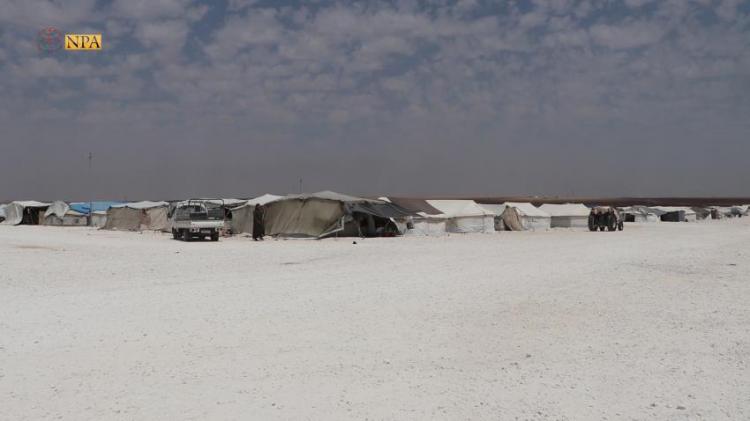Al-Rukban Camp IDPs: Women were giving birth on walls
Al-Tabqa – North-Press Agency
Jindar Abdulqader
Over nine years of the Syrian crisis, displacement, homelessness and suffering remain the common situation of millions of Syrians, moving from one place to another in search of a safer place.
The situation of the internally displaced people of Al-Rukban camp was the worst compared to other camps inside and outside the Syrian borders, where they endured unsafe and unhealthy living conditions during their stay in al-Rukban camp on the Syrian-Jordanian borders.
Suffering and death
Abdullah al-Ameri, a man from the eastern countryside of Homs described the situation in al-Rukban by saying: “There were people and children dying of hunger as many others of them were without a supporter.”
“When the Islamic State (ISIS) took control over Palmyra, we headed south, towards al-Rukban camp. We stayed there for four years, living in a tragic situation, no humanitarian aid nor relief was provided to us, in addition to the high cost of living,” al-Ameri said.
“We used to buy food from the traders, prior to cutting off the road of which the traders were prevented from bringing the food through, the prices of materials were doubling higher and higher,” he added.
He described the suffering of the residents by saying “the displaced people were walking about (3) kilometers to fetch water from the Jordanian side, and that water was not clean at all.”
Displacement from al-Rukban Camp
Al-Ameri along with his family decided to leave al-Rukban camp, he pointed out that those who were not required for conscription by the Syrian government had returned to their homes. “While the others were smuggled to reach al-Mahmoudli camp in al-Tabqa within the Syrian Democratic Forces (SDF) controlled areas,” he explained that, “we have paid amounts of up to 300 thousand SYP for smugglers”.
He added that they are afraid to return to their areas “because there are those who work for the Syrian government and write malicious reports”.
Jungle law
Al-Ameri likened al-Rukban camp to a jungle, “where there is no law, the strong eats the weak, there were cases of killing and armed robbery, and people who died of hunger, we only got aid once every 6 months or more, after agreements of allowing organizations to reach the camp, were made.”
Fayez al-Sedral, another man from Homs countryside, Palmyra desert, told North-Press that women were giving birth on walls surrounding the camp, “if medical teams didn’t come from the Jordanian side, the women die, medical services were very bad,” he said.
Al-Rukban camp was established in the Syrian-Jordanian bordering area, in the Syrian side for the Syrian IDPs with a length of 7 km from the demilitarized area between Syria and Jordan, with a depth of 3 km. Thousands of Syrians had escaped to the area in search of security after the Islamic State (ISIS) controlled many areas in eastern parts of Syria.
The number of IDPs in this area was about 85,000 in January 2017, who weren’t allowed to enter the Jordanian territories except for emergency cases.
After ISIS attacked Jordanian border guards in 2016, international relief organizations feared entering the camp and treated only the wounded and sick people at a UNICEF medical center on the Jordanian side.
The area on the Syrian side is theoretically protected by the Syrian tribal army, which was trained in Jordan to fight ISIS.
While al-Mahmoudli camp was established on 24 June this year, to receive IDPs from al-Twehniyah camp, which lacked services in addition to its poor geographical location, as it’s nearby the Euphrates River. Al-Mahmoudli camp includes about 5,410 people distributed to 1,277 families, 80 of whom are from al-Rukban camp.

